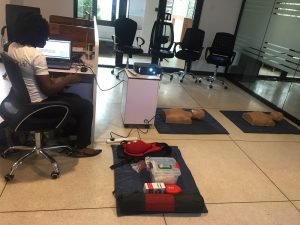CPR saves lives! A simple guide to performing CPR on an Adult.
Everyday emergency situations happen, it could be someone choking, a drowning, a sudden cardiac arrest or heart attack. When you think of the fact that the heart has been beating continuously since one was in the womb, that’s amazing! But many things threaten to stop the heart and when a person’s heart stops, they stop breathing whether they are young or old.
We believe this is a good reason to learn to help someone who has stopped breathing and maybe save their life?
Why should we learn CPR?
When someone stops breathing their heart has also stopped. Once this has happened, you have approximately 4 minutes before brain damage begins. By learning some simple lifesaving techniques, we can sustain a person’s life until a defibrillator is available or Emergency Medical Services arrive.
What is CPR?
CPR stands for cardiopulmonary resuscitation, cardio meaning heart, pulmonary meaning lungs and resuscitation meaning to “Restore” or “Revive”.
When someone stops breathing it is possible to breath for them by blowing air into their lungs through their mouth, this is called rescue breathing or ventilation. It is also possible to manually pump a heart that has stopped beating by pressing down on the centre of the chest at a fast rate, this is called chest compressions.
Why does CPR work?
Chest compressions manually operate the heart by pumping the chest and causing oxygenated blood to be circulated around the vital organs of the body.
Rescue breathing (ventilations) works because the air that we exhale still contains enough oxygen to be used again. Specifically, air contains around 20% oxygen and we only use around 6% of that so there is plenty left to sustain a life.
Can we really save a life as a bystander?
It is absolutely possible. As a layperson with knowledge of how to do CPR, you can make a difference. You need to know that it is unlikely that giving CPR alone will revive a casualty but you can keep their vital organs supplied with oxygenated blood until the ambulance arrives. If you did nothing and just waited, the casualty would surely die.
Don’t be afraid of trying
If the person has stopped breathing then you cannot make the situation worse. We do however recommend that you attend a lifesaving, certified First Aid Training course to help you prepare for all first aid emergencies.
How does one start?
It is critical to remember that calling an ambulance on your medical centre may be the most important step you can take to save a life. If someone else is present, they should call an ambulance immediately. If you are alone, try to call for help before beginning CPR.
STEP1: Check for Danger
Always remember to use common sense when faced with an emergency situation and do not act impulsively and place yourself and others in danger. Although helping a casualty should not be delayed, only approach after checking that it is safe to do so.
Always check for gas, bare electrical cables, spills, cars, smoke, fire and any other potential hazards before attempting to help someone. Do not put yourself in danger as you might become a victim also.
STEP2: Breathing Check
Check that the casualty is unresponsive by tapping them on their collarbone and shouting, “Are you okay, may I help you?”, “What is wrong?” etc
Asking for permission to help someone is important, even if they do not respond. If there is no response, check if the casualty is breathing as follows:
- Open the casualty’s airway by placing two fingers under the bony part of their chin and then place the other hand on their forehead.
- Now gently tilt the head back by pushing upwards on the chin and downwards on the forehead.
- Put your cheek close to their mouth and listen and feel for breathing whilst looking towards the casualty’s chest to see if it is moving.
- Do this for no more than 10 seconds.
If you haven’t already called for help, do so now and call 767, 112, your medical centre or get someone to call for you. You should ask emergency services to bring an AED or defibrillator.
You are now going to need to start CPR immediately.
STEP3: Chest compressions
When performing chest compressions, proper hand placement is very important. Move the casualty onto their back if they are not already in that position and expose the chest by removing clothes.
- Locate the compression area by putting the heel of one hand on the lower half of the breastbone. Put your other hand on top of the first and interlock your fingers.
- Try to keep only the heel of your hand on the compression spot, keep your fingers on their chest.
- Lock your elbows and whilst positioning yourself directly over the casualty and using your own body weight, compress the chest. You should press to a depth of around 5cm in an adult or a third of the chest size.
- Continue to push and release at a rate of at least 100 – 120 compressions per minute which is almost 2 compressions per second. Around the same rhythm as “Stayin’ Alive” the hit song from the Bee Gees
Avoiding pushing on the ribcage and keep the movement smooth and controlled. Continue for 30 compressions, it may help to count to 15, twice, and out loud.
Now it’s time to perform rescue breathing.
STEP4: Rescue Breathing
First open the casualty’s airway by placing two fingers under the bony part of their chin and then place the other hand on their forehead. Now gently tilt the head back by pushing upwards on the chin and downwards on the forehead. (the same way we checked for breathing).
Use a barrier such as a face shield or ventilation mask to avoid passing fluids between yourself and the casualty. Carrying barriers in a personal first aid kit is a good idea. You can learn more about this on a first aid course.
Pinch the casualty’s nose closed. Give two rescue breaths by placing your mouth on the casualty’s mouth and blowing.
Each breath should last about a second and provide enough air to make the casualty’s chest rise.
Repeat the Sequence
After delivering 2 rescue breaths, begin another cycle of 30 compressions. Continue this sequence of 30 chest compressions to 2 rescue breaths until:
- The casualty is revived
- Emergency medical services arrives
- Another rescuer takes over
- You are too exhausted to continue
Note:
- This guide is not meant as a substitute for proper first aid training.
- This guide is with relevance to performing CPR on an adult and the technique varies for infants and children.
- You can learn more by joining one of our first aid trainings where you will be able to practice CPR skills using a CPR manikin.
- Never practice on a normally breathing person.
To learn CPR & First Aid, contact us or call 08177321761 for more information.



